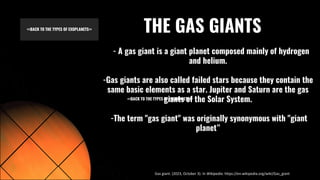The Milky Way Galaxy and The types of exoplanets.pdf
- 1. THE MILKY WAY GALAXY TAN,CLARICE DANNIELLE D. VIII-RED LAUAN <<START READING>> Did you know that our star, the Sun, is just one of hundreds of billions of stars swirling within an enormous cosmic place called the Milky Way Galaxy?
- 2. THE MILKY WAY GALAXY TYPES OF PLANETS IN THE MILKY WAY GALAXY MAIN MENU FUN FACTS ABOUT THE MILKY WAY GALAXY PLEASE PRESS THE PICTURES OF THE TOPIC OF YOUR CHOICE MAIN MENU <<BACK TO FIRST PAGE>> THE MILKY WAY GALAXY TYPES OF EXOPLANETS IN THE MILKY WAY GALAXY
- 3. The Milky Way is a huge collection of stars, dust and gas. ItŌĆÖs called a spiral galaxy because if you could view it from the top or bottom, it would look like a spinning pinwheel. The Sun is located on one of the spiral arms, about 25,000 light years away from the center of the galaxy. Even if you could travel at the speed of light (300,000 kilometers, or 186,000 miles, per second), it would take you about 25,000 years to reach the middle of the Milky Way. <<BACK TO MAIN MENU>> THE MILKY WAY GALAXY
- 4. TYPES OF EXOPLANETS IN THE MILKY WAY NEPTUNIAN GAS-GIANT SUPER-EARTH TERRESTRIAL <<BACK TO MAIN MENU>>
- 5. TERRESTRIAL PLANETS A terrestrial planet, telluric planet, or rocky planet, is a planet that is composed primarily of silicate rocks or metals. Within the Solar System, the terrestrial planets accepted by the IAU are the inner planets closest to the Sun: Mercury, Venus, Earth and Mars. -The terms "terrestrial planet" and "telluric planet" are derived from Latin words for Earth (Terra and Tellus), as these planets are, in terms of structure, Earth-like. Terrestrial planets are generally studied by geologists, astronomers, and geophysicists. Terrestrial planet. (2023, October 7). In Wikipedia. https://en.wikipedia.org/wiki/Terrestrial_planet <<BACK TO THE TYPES OF EXOPLANETS>>
- 6. THE GAS GIANTS - A gas giant is a giant planet composed mainly of hydrogen and helium. -Gas giants are also called failed stars because they contain the same basic elements as a star. Jupiter and Saturn are the gas giants of the Solar System. -The term "gas giant" was originally synonymous with "giant planetŌĆØ Gas giant. (2023, October 3). In Wikipedia. https://en.wikipedia.org/wiki/Gas_giant <<BACK TO THE TYPES OF EXOPLANETS>>
- 7. THE SUPER-EARTH -A Super-Earth is a type of exoplanet with a mass higher than Earth's, but substantially below those of the Solar System's ice giants, Uranus and Neptune, which are 14.5 and 17 times Earth's, respectively. -The term "super-Earth" refers only to the mass of the planet, and so does not imply anything about the surface conditions or habitability. Super-Earth. (2023, September 5). In Wikipedia. https://en.wikipedia.org/wiki/Super-Earth <<BACK TO THE TYPES OF EXOPLANETS>>
- 8. THE NEPTUNIAN PLANETS -Neptunian planets are similar in size to Neptune or Uranus in our solar system. -They likely have a mixture of interior compositions, but all will have hydrogen and helium-dominated outer atmospheres and rocky cores. WeŌĆÖre also discovering mini-Neptunes, planets smaller than Neptune and bigger than Earth. Overview of the planet types. (2022,April 13). In NASA. https://exoplanets.nasa.gov/what-is-an-exoplanet/planet- types/overview/#:~:text=Neptunian%20planets%20are%20similar%20in,Neptune%20and%20bigger%20than%20Earth. <<BACK TO THE TYPES OF EXOPLANETS>>







